It was an exciting day at the fair.
The county hosts a special event each year for anyone interested in growing #fruit so we can buy and exchange #scions to #graft onto our #fruit-trees. They sell all kinds of fruit trees (not just apples) and supplies. Experts are available to answer questions, and help us to perform advanced #grafts.
This event is called the Fruit #Propagation Fair and Scion Exchange, and that is what this post will be all about today.

Last year I went to this fair for the first time, and I arrived completely unprepared because I didn't know what to expect. All I knew was that I wanted to grow apples inexpensively. I knew nothing about the choices I would have to make, or the knowledge I would need to make appropriate choices.
This year was a total 180 difference, because I knew what to expect, I did some research, I came prepared, and I had a strategy.
Here are the major headings in this post, explaining my strategy for navigating the fair...
- 1: Be Prepared
- 2: Arrive Early
- 3: Choose Apples Before Arrival
- 4: Select A Rootstock
- 5: Grafting
- 6: Purchase a Grafting Knife
- Mission Complete
1: Be Prepared
Things to bring:
- plastic bag with a little bit of wet mulch inside, to carry scions
- blue painters tape and marker pen to label scions
- aluminum labels and ball point pen, to label grafted trees
- camera, notebook, cash

2: Arrive Early
Many people from out of state drive a long way to attend this fair. The first 10 minutes after they open the doors are the craziest. You think a Comic Con is scary? A Pokemon convention with pre-adolescent children? Walmart on Black Friday?
You ain't seen nothin' yet.

Hundreds of farmers, grocers, wine-makers, cider makers, knife hobbyists, suburban gardeners, and barefoot children running circles around parents, all of them ready to wreck anyone in their way.
So, I showed up an hour before the doors opened, to get near the front of the line.
While we were waiting, people were calmly chatting about the type of fruit they have growing at home. There was a strange fellow who suddenly turned to me to ask a question jokingly.
Why are there so many Scientologists here?
Me: I don't know, why?
Because they are collecting Scions. Get it? Sciontologists.
Ooh good grief. Apple humor. Although, I have to admit, that was a pretty good pun. A #scion is the term for an apple stick that you graft onto an apple tree to grow fruit from it.

The doors opened finally, and I paid my $7 entry fee.
It was great. I had free access to the entire room.
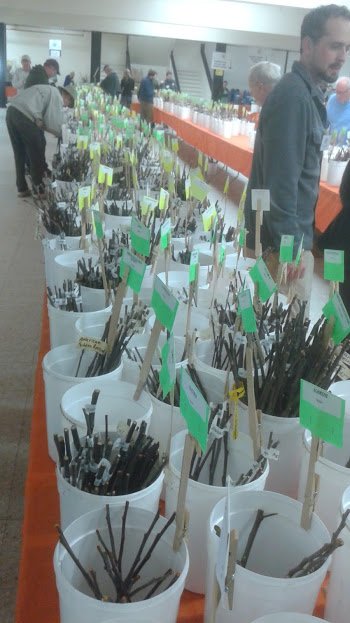
Looking around the room, I could hear angels singing the Johnny Appleseed song in my head.
3: Choose Apples Before Arrival
It has been a whole year since the last fair I went to, so I had a lot of time to think about which apple scions I needed to find at this year's event.
There are basically two rules inside the fair:
- Grab It and Tag It.
- Take only one scion per bucket.
It's basically a free for all. No mercy for the small and weak.
People who are in the back of the line want to be able to have a full selection of scions to choose from too. A lot of people grab a handful of scions thinking they're going to build a huge apple tree orchard some day with tons of fruit varieties on their first tree. In reality, that won't work when starting an apple tree for the first time. Volunteers have to watch out for this, and remind people to put back any scions they won't be grafting this year, to save some for people still waiting in line to find scions.
These are the apples I wanted to find:
- Northern Spy
- Gravenstein
The tables had hundreds of apple scions, all labeled in alphabetical order around the room.
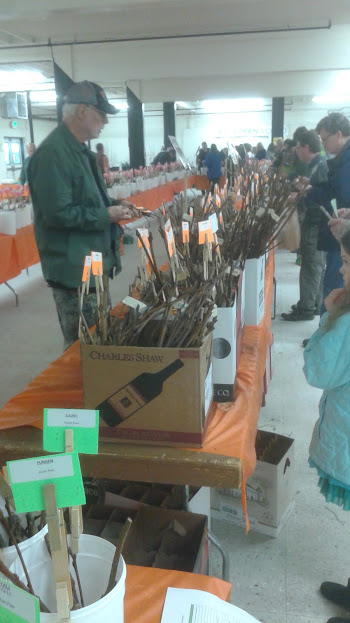
There were three different kinds of #Gravenstein apples (green, yellow, red). Oh Lord! Choices, choices, choices! I was not prepared to make this decision.
I did not know if there was any significant different between them, so I picked red.
Gravenstein is a sweet and slightly crisp apple. The flavor reminds me of spiced apple cider. The flavor actually changes over time from sweet to more rich and robust.
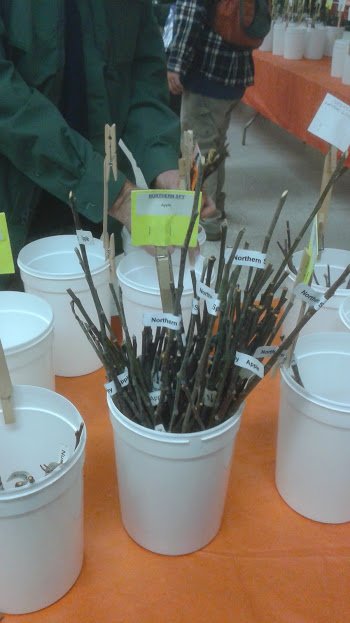
At first I could not find #Northern-Spy. I really, really wanted this apple, because I knew it was going to help pollinate my Sweet 16 variety I had grafted last year. Northern Spy is actually the parent breed of Sweet 16, and I'm excited to be able to compare their unique licorice sweet candy flavors one day in the future when I am able to produce my own fruit.
Fortunately, this bucket right in front of me was overflowing with the scions I was looking for. How could I have overlooked it?
Grab it and tag it
Done!
4: Select A Rootstock
There are two types of #rootstocks to choose from for growing an apple tree in a container, the way that I do. One is called M-27, which is a full dwarf variety that has a shorter lifespan. The other is called M-9, and it is a semi-dwarf variety that lives slightly longer.

There are dozens of rootstocks varieties for sale here. They are sold bare root, and they give you a bag of wet sawdust with it to keep the roots moistened. They won't sell you a #rootstock for your scions if you don't know which kind to get. Instead they will direct you to a different line so you can first consult an expert to give you advice.
Fortunately, I already knew what I needed, and I was able to get through the line very quickly.
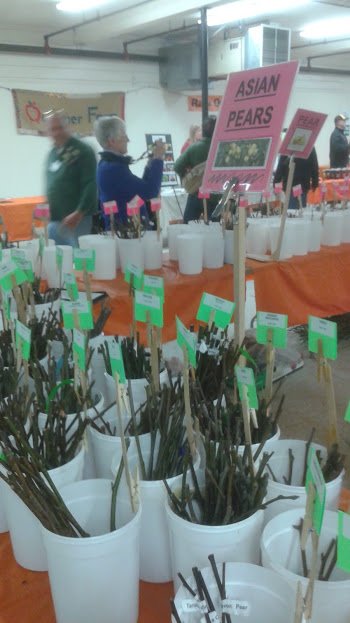
If you show up at the rootstock counter and order an M-27 with one of these pear scions in your hands, then they will probably send you to consult an expert first, or ask you to return your scion where you found it. Pears don't grow on apple trees.
I chose the M-9. The price was $5. I already have an M-27 at home growing nicely, and I want to have both of these varieties growing at home. In the future I might be able to grow my own rootstocks from each of these by cutting off a piece of mature root.
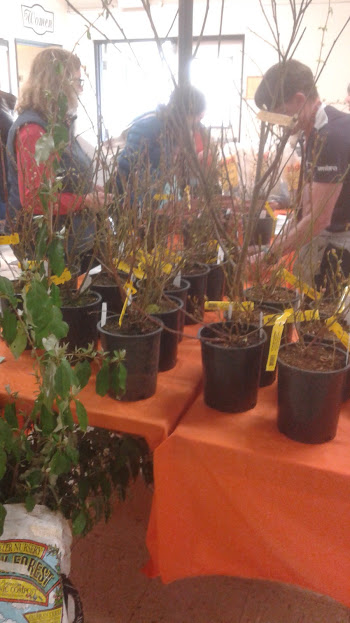
Various pre-grafted trees for sale, such as figs and pears.
The rootstock is important to the health of a tree, because it provides disease resistance, tolerance to many soil types, makes the tree more hardy, and it determines the height and growth rate of the tree. The fruit of a rootstock alone will not taste good (or it may not produce fruit at all), which is why people graft the scions from better tasting fruit onto it.
Most trees you buy at a garden store are already a grafted to an appropriate rootstock, so you can have plentiful flowers, delicious fruit, or beautiful leaves growing from a root that will make it more hardy, disease resistant, and dwarf-like.
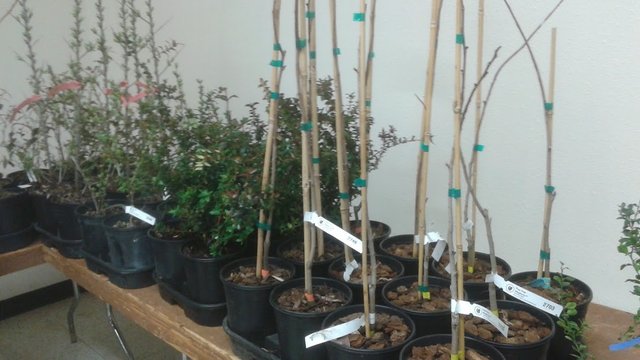
Vendors were selling some of the most popular fruits trees and shrubs. I think I see some citrus and paw-paws for sale here.
Some people grow apple trees from seeds. Seed grown apples will almost always be a tall, full-sized tree with good disease resistances. A seed grown tree might not ever have a good tasting apple though, and its fruit will be based on the genetics of the type of apple tree that pollinated it. A seed grown from a Fuji apple will not produce apples that taste exactly like a Fuji. It will probably be different in flavor, texture, size, color, etc..
So now I've got my rootstock, my two scions, and I'm ready to graft.
5: Grafting
While mobs of crazed fruities were funneling into the scion room like a stampede of elephants in heat, I found my way across the room and located the grafting experts.
There was a man at a counter who charged me $5, and handed me ticket #1.
Damn, I'm good!
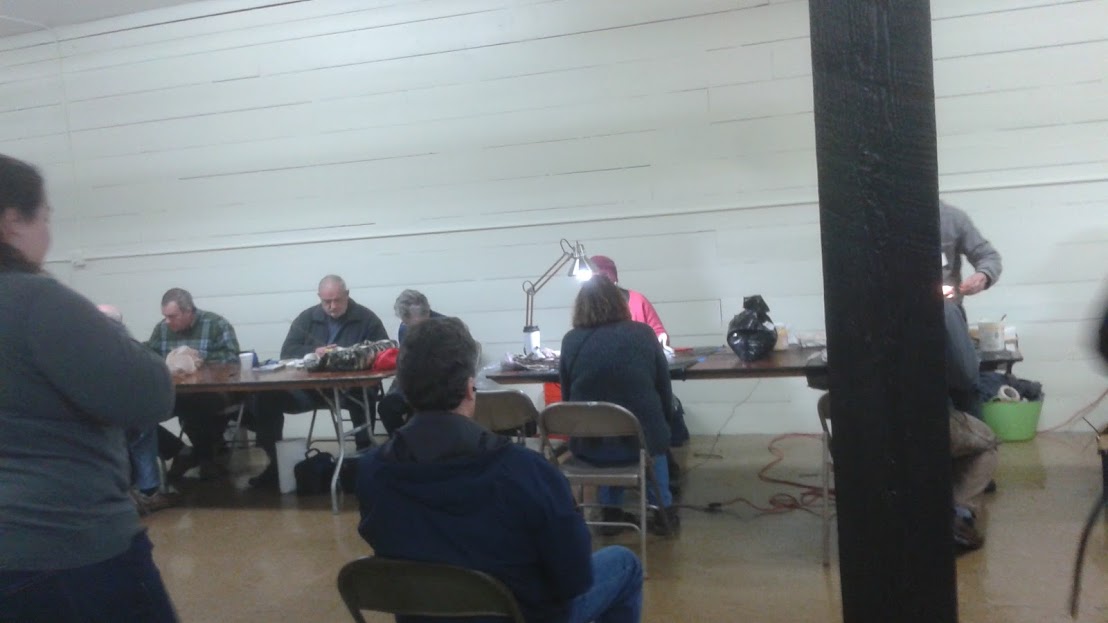
The room looked exactly like a prisoner interrogation chamber with dangerous torture devices across the tables. I walked up to the grouchy looking old guy with a table full of gear in front of him. Something inside me told me this geezer probably had the sharpest knife in the drawer.
He told me my scions were too small, because my rootstock was very thick, and explained why having them the same size would be more ideal.
I wasn't about to head back through the horde of heifers to buy a new rootstock and ask for a smaller one, and I knew the scions I looked at where nowhere near the the size of the rootstocks they had available. The scions were all about a quarter inch smaller than the rootstocks. After talking about the difficulties with The Godfather of Grafting, he decided he would go ahead and perform the operation for me anyway.
I handed him my rootstock and my scion, and he whittled away at it for a few minutes, and quickly had it taped up with a perfect Whip-And-Tongue style graft. He didn't use any messy wax. Plain old rubber electrical tape was all he used to wrap the graft cleanly.
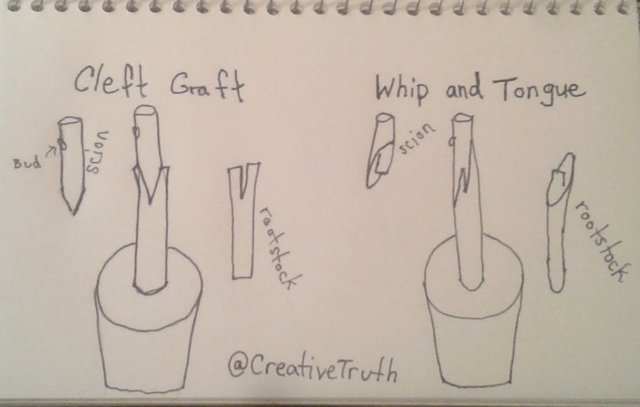
Cleft Graft is much easier, but it has less success rate than the advanced Whip and Tongue graft. The reason the Whip and Tongue graft, if done properly, is more successful is because there is more surface area for the living cambium layers to line up with, and it fits together for a tighter grip.
Honestly, I wanted to take some photos of his work, but the area was cluttered with his bag of stuff, so I couldn't really get a good shot from anywhere. He didn't seem to want to be on camera or watched too closely either. He did have me sit behind the table afterwards, and had me practice making a grafting cut on a few scrap pieces. I screwed up each piece he had me cut: too much slant, not enough slant, cutting too deep, cutting not deep enough, uneven cuts.
Slicing through wood with a smooth edged blade is harder than it looks.
He showed me the right way to use a grafting knife, and it looked like he was slicing off potato skins with thin even slices. It looked so easy.
He had multiple knives. One was for cutting across the grain, and one for cutting along the grain. One was better for cutting up and out, and one was better for cutting down towards the body. There was also a special budding knife he demonstrated for me, which allows him to slice through just the bark of the wood to insert a small bud graft.
The younger grafting expert beside us was joking about accepting Bitcoin to pay for his services just as we were cleaning up. I shook the wise old sage's hand, and thanked him for working with me so patiently.
6: Purchase a Grafting Knife
They have a vendor at the fair who sells all kinds of grafting supplies and specialty grafting knives. They will even sharpen old grafting knives for you.

This is the #blade I selected. I chose it because it was mult-purpose for bud grafting and normal grafts. They also had a non-folding #knife, but I don't have anything to sheath the knife into, so I opted for a folding knife.
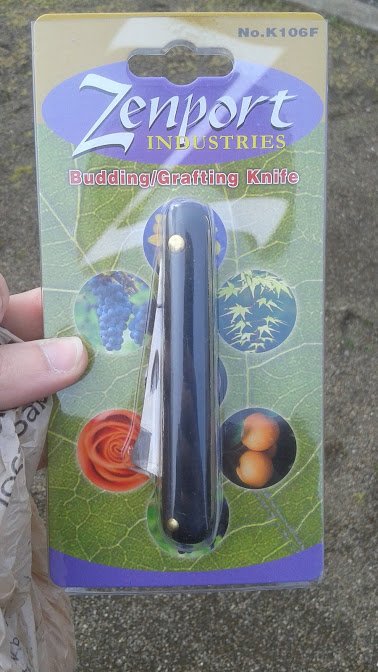
Explicit language warning. Skip this next paragraph if you are squeamish about #knives and blood.
All of these knives really freak me out, to be perfectly honest. For some reason I can't help myself from imagining that I might mishandle the folding knife and cause it to spring the blade into my knuckles, or stab it through my palm accidentally if I cut too deeply through the wood after getting it unstuck from a jam in the wood. Someone might come up behind me and ruin my concentration, causing me to suddenly jerk the blade along my thumb. Are these fears irrational?
It is going to be a learning process, to become accustomed to working with a grafting knife. When I take it home, I'm going to make sure I keep it clean and sharp, and use great care with it to avoid injuries.
The cost of the grafting knife was $14.
Mission Complete
So I made it through the entire fair and accomplished all of my goals in approximately 30 minutes. When I left I couldn't even see the buckets on the tables, because the room was so full.
One of the volunteers thanked me for attending on my way out, and she congratulated me because she recognized me from the front of the line with the others who arrived early.

If I didn't come prepared, I would have been stuck walking around aimlessly with a million questions, like I did last year.
- What type of rootstock is best for growing an apple tree in a container?
- What type of apples taste the best for eating right off the tree?
- Is the apple going to be sweet, tart, mild, soft, crisp?
- How do I graft a scion to my rootstock most successfully?
- Will I need a specific apple variety to pollinate my tree to produce apples?
- Which diseases should I look out for on the apples I am growing?
They have a whole table of volunteer experts you can wait in a line to talk to, and these guys know everything, but they also have a whole crowd of people to help, so it is good to do some research of your own too.
I did my research, and I came prepared, and I felt like when I I left, I was an apple fair rockstar.
And in 365 days, I'll be back for the next year's Scion Exchange.

Next time I'll be sharing photos from my recent Bonsai Club meeting. We finally started working on our rock landscapes, and it was a ton of fun. So stay tuned for that.
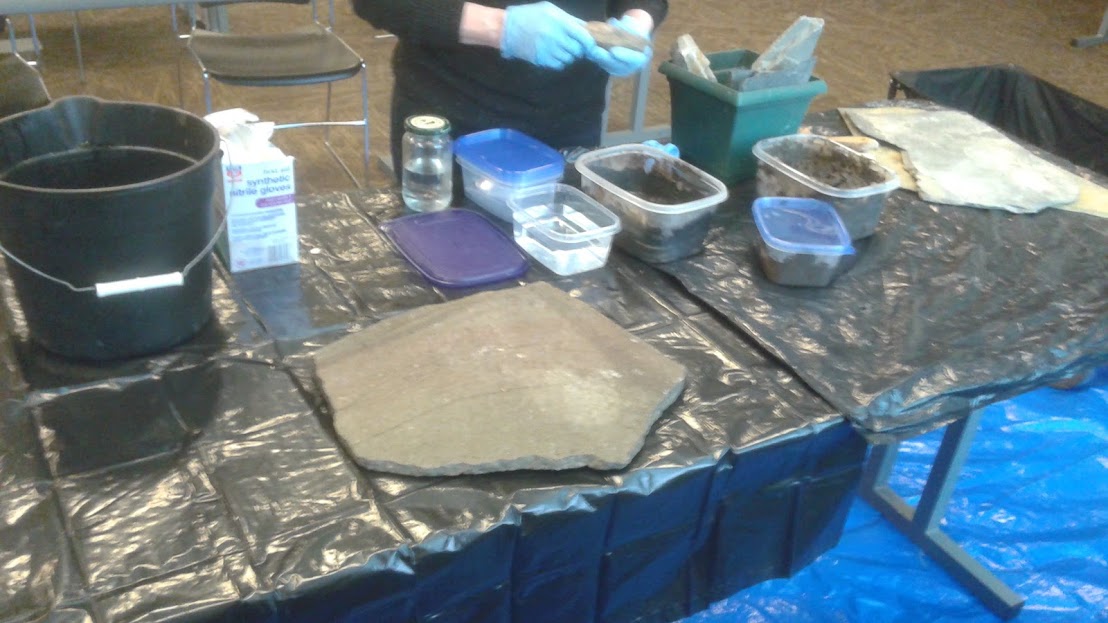
Have a wonderful week!

Excellent publication @creativetruth, I would like to make an event like this in my city but with coffee hehe
Downvoting a post can decrease pending rewards and make it less visible. Common reasons:
Submit
Very usefull and complete article about apple article, thank you very much for your sharing to us valuable information, i have upvote and resteem your post to more than 1450 my follower to make more people know about gardening apple, greeting friendship from me @abialfatih in aceh indonesia
Downvoting a post can decrease pending rewards and make it less visible. Common reasons:
Submit
Seems legit.
Downvoting a post can decrease pending rewards and make it less visible. Common reasons:
Submit
Really nice article. I have been interested in grafting and this event sounds very interesting. I will have to see if there is anything like this around me. Several good points on navigating the event. I will have to do lots more research on grafting I am sure before I make attempts at it.
Downvoting a post can decrease pending rewards and make it less visible. Common reasons:
Submit
Make sure you try out as many types of apples at the grocery store as you can, to learn which ones you like, and don't like. Or if you want apples for pies, applesauce, juice, or cider, find out which apples are used for that.
Downvoting a post can decrease pending rewards and make it less visible. Common reasons:
Submit
apple fruit is very much vitamin him my friend .. please help me once friend yes
Downvoting a post can decrease pending rewards and make it less visible. Common reasons:
Submit
Congratulations! Your post has been selected as a daily Steemit truffle! It is listed on rank 8 of all contributions awarded today. You can find the TOP DAILY TRUFFLE PICKS HERE.
I upvoted your contribution because to my mind your post is at least 18 SBD worth and should receive 86 votes. It's now up to the lovely Steemit community to make this come true.
I am
TrufflePig, an Artificial Intelligence Bot that helps minnows and content curators using Machine Learning. If you are curious how I select content, you can find an explanation here!Have a nice day and sincerely yours,

TrufflePigDownvoting a post can decrease pending rewards and make it less visible. Common reasons:
Submit
How does this bot work? Is this over-hyped or does it really deliver? I guess we'll find out.
Downvoting a post can decrease pending rewards and make it less visible. Common reasons:
Submit
Beware lemon tree, there's a new knife coming home! lol bad joke I know, but I'm sure you will be playing a lot of Dr Frankestein between this fair and the other! I don't know what surprises me the most, your way of narrating this experience or the fact that these exchanges are as great as they get. I really had many laughs while reading, pretty cool writing too, I must say! You did your homework and exceled at it, as always. Can't wait to see your apple trees grow! Good luck and happy vibes!
Downvoting a post can decrease pending rewards and make it less visible. Common reasons:
Submit
Yeah, I guess that's my inner anxieties motivating my strategies and narration. Get in, and get out to avoid the crowd. A lot of these guys have a lot of useful knowledge I could probably benefit from by talking to more people, but I get nervous. Sometimes I feel like if I am going to talk about my bonsai, gardening, or fruit tree projects, somebody else more respected may jump in and say that I'm doing it all wrong, and people shouldn't listen to me. Sometimes I feel that way about sharing on steemit too, but it gets easier knowing I get a lot of encouragement just for making an effort.
You'll have to explain the lemon tree joke to me, because I don't get it.
Downvoting a post can decrease pending rewards and make it less visible. Common reasons:
Submit
You told me you only had a lemon tree. That one could be grafted like you have no idea! I have so many varieties that I would spend my whole life just learning about the species I have (grafted by others) and which type of grafting was used for each one of them.
I think I didn't know about the whip and tongue type of graft either, or maybe I saw it going by another name. I have tangerine-lemon trees, persian lemon trees, many of them are seedless (don't really know if they were grafted that way), but why I don't really have at all are pears and apples. You can buy apples here (plants and scions never), maybe two, three different kinds, but they are as expensive as scarce now, as the crisis keeps on devouring our economy and an entire country capacities. Most apples here I think are imported, but maybe there are lots of apple trees in cooler regions of my country. I did start a couple of apple seeds 4 years ago, and I succeeded, but after a couple of months they died because of the heat. I know I can now grow one for a longer time, maybe even get it to fruit here, but that's another story...
Citrus plans, as pears and apples, have an especial capacity to be grafted. That was the joke I intended, as you bought one cool knife, I thought that maybe a lot of grafting is going to be attempted at home. So, thats a bad joke explained lol. Cheers!
Downvoting a post can decrease pending rewards and make it less visible. Common reasons:
Submit
Currently I have a few different citrus plants all grown from seed. Two common lemons, a meyer's lemon, and a mexican lime. When I grow from seed, I don't think they are really the same as the fruit variety they came from, maybe you can tell me about how similar they are likely to be. Unfortunately, I keep them all bonsai sized because I don't have space indoors for the winter for them to grow as a full sized fruiting tree. I really do love them though. The leaves have the most wonderful scent.
Downvoting a post can decrease pending rewards and make it less visible. Common reasons:
Submit
They are really strong plants indeed. I think you're right about varieties. As apples, they do change a lot from a generation to the next one, but you can always graft them as well. The good thing about lemons and many citrus is that you can easily have them fruit as bonsai. My own technique involves having most of my trees strictly into pots, and they don't receive direct sunlight, because that interrupts the humidity cycle going on in the soil and above it too, and I've learned that a plant's growth can be proportional to the ammount of time interacting with water and the nutrients it transports from the soil/surface.
I like to mix it up between what I'm learning and what I notice/study on my own. I'm constantly getting better results: bigger, powerful and solid coloured leaves, bigger fruits and flowers. It's like having a "greenhouse" in my yard, but I maintain humidity as if it was a hydroponic system, instead of occasional watering, I keep the whole plant moisted enough, without soaking it down. I have had very big lemons from an 2-3 ft plant in a pot, but not too much in quantity, no more than 3, 5 lemons at the same time. I believe I have hybrids between mexican lemon trees and other lemon varieties, I have maybe 5 or 6 that are grafted, but I'll have to learn a lot more about them to get even better results! In total I must have around 12-15 lemon trees that I have been buying for the last three years. And the rule I follow to prune them is to cut always after 3 nodes from each branch-stem. That way I maintain the principal trunk and it doesn't fall with its weight. I also read a while back that this pruning technique helps the lemon tree (oranges too, I think) to fruit more lemons, which can sprout really close to each stem.
Downvoting a post can decrease pending rewards and make it less visible. Common reasons:
Submit
All of my citrus trees are sprouting new branches every once in a while lately. I turn around, and there is suddenly a two inch branch where there wasn't one before. I think that means they are wanting to be put outside, because they are ready for spring.
I would like to learn more about the pruning method you describe. Are you saying you prune every third node to open up space for air and light? I might need a drawing to visualize it.
I'm also trying to decide if I should defoliate some of the leaves, as they can get very large in proportion to the tree. I prefer to see many leaves on all the branches, instead of all big ones with only a few getting most of the light.
Downvoting a post can decrease pending rewards and make it less visible. Common reasons:
Submit
That means the soil you're using for them has lots of nutrients, I also learned that many frugal plants or maybe most of them don't really need direct sunlight, but that's not going to be an issue for you, and for that reason you're getting bigger and heavier leaves. As you've figured already, your plants (super easily) sprout new stems and leaves, and because of that you have sort of a bonsai situation, I would reccomend to prune their roots as well, but not as occasionally, only when you know they won't fruit (flowers are not a problem, they're super small). Pruning every third node goes like this:
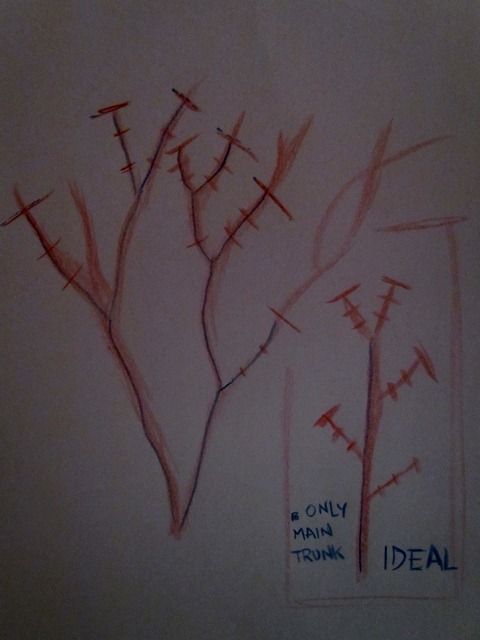
I think you have more experience than me on this, but I suggest this way of pruning when you have them in pots and want the fruits to be better developed and not dropping its branches by their weight. A lemon needs several years and a lot of space to become full size trees, and for that reason we want to only have one main trunk, and every branch cut to their third node (all the time, not once in a while), that's why I put there an "ideal" way of growing a bonsai lemon tree into a pot. If you have them with already two to three, or even more main trunks, you carry the same pattern into each one. What you will obtain from this is to have the plant fruit only over each main branch, instead of all over the place, where you will probably have problems with the fruits developing or even drying the leaves and stems of the plant as the fruits start to grow. With the leaves you can cut them if you want, but I think that as your plants get much older, and you prune it enough to stay one size, they will grow smaller leaves eventually, as the plant reach enough maturity, as a bonsai would. The main idea is to try to keep each plant one sized or letting it grow with certain caution over the number of main branches and stems, because if you don't do that from the start, you're probably going to have a mess of branches and thorns all over, and not having enough space to work on. My suggestion is to keep the tree simple enough and with fewer branches-trunks as possible. Pruning it maybe monthly or between months alternating as you supervise and plan its growth.
Maybe I'm leaving some tips or information left out, I'll wait for your reply, as I'm going to make some lunch for the family right now. Cheers!
Downvoting a post can decrease pending rewards and make it less visible. Common reasons:
Submit
Okay, so what you call a node is a leaf, bud, or new stem?
Not following the rule of 3, is probably why I am getting new stems appearing mostly lower on the trunk instead of on the older, longer branches.
Maybe I'll post a photo and diagram, so you can help me determine the best way to increase healthy leaf spread, and improve the tree for the future, and maybe get fruit one day.
Downvoting a post can decrease pending rewards and make it less visible. Common reasons:
Submit